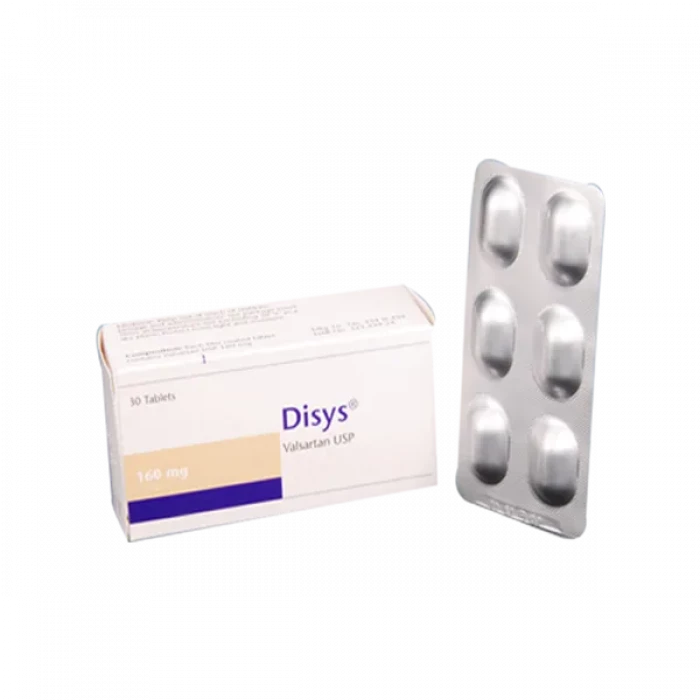
✔ 100% Authentic Product
👁️ Currently Viewing 1519
Disys 160mg Tablet
Tablet Manufacturer/Distributor: Healthcare Pharmaceuticals Ltd. Generic Name: Hydrochlorothiazide 12.5 mg + Valsartan 160 mg Tablet
Discount
Price: ৳ 102
MRP:
৳
108
6%
Off
✅ Description:
Indications
Valsartan is indicated:
- For hypertension
- To reduce hospitalizations in patients with congestive heart failure
- To reduce death in patients who developed congestive heart failure after myocardial infarction
Pharmacology
Valsartan is an oral medication that belongs to a class of drugs called angiotensin receptor blockers (ARB). It is a specific orally active angiotensin II antagonist that acts on the AT1 subtype. The binding of angiotensin to its receptors causes blood vessels to narrow (vasoconstriction), which leads to increased blood pressure (hypertension). Valsartan blocks angiotensin II receptors. By blocking the effects of angiotensin, valsartan dilates blood vessels and lowers blood pressure without affecting pulse rate. The affinity of valsartan for the AT1 receptor is much higher than that for the AT2 receptor (about 20,000 times). It does not bind to or block other hormone receptors or ion channels that are known to be important for cardiovascular regulation.
Dosage & Administration
Hypertension: The usual dose of Valsartan is 80 to 160 mg once daily. The maximum dose is 320 mg daily. Maximum blood pressure reduction occurs within 4 weeks.
Heart failure: The usual dose is 40 mg twice daily and may be increased to 80-160 mg twice daily.
Post-Myocardial Infarction: The initial dose after myocardial infarction is 20 mg twice daily. The dose should be increased with a target of 160 mg daily if tolerated without side effects.
Administration of Valsartan with food decreases the absorption of Valsartan by about 40%, so it should be taken on an empty stomach. No initial dosage adjustment is required for elderly patients with mild to moderate renal and hepatic insufficiency.
Interaction
No drug interactions of clinical significance have been found. Compounds which have been studied in clinical trials include Cimetidine, Warfarin, Furosemide, Digoxin, Atenolol, Indomethacin, Hydrochlorothiazide, Amlodipine and Glibenclamide
As Valsartan is not metabolized to a significant extent, clinically relevant drug-drug interactions in the form of metabolic induction or inhibition of the cytochrome P450 system are not expected with Valsartan. Although valsartan is highly bound to plasma proteins, in vitrostudies have not shown any interaction at this level with a range of molecules which are also highly protein bound, such as Diclofenac, Furosemide, and Warfarin. Concomitant use of potassium sparing diuretics (e.g., Spironolactone, Triamterene, Amiloride) potassium supplements, or salt substitutes containing potassium may lead to increase in serum potassium. If co medication is considered necessary, caution is advisable
Contraindications
Valsartan is contraindicated in patients who are hypersensitive to any component of this product.
Side Effects
Valsartan is typically well tolerated, with only a few adverse effects. Headache, dizziness, tiredness, stomach discomfort, cough, diarrhea, and nausea are the most frequent adverse effects. Hyperkalemia, impotency, decreased renal function, allergic reactions, dyspnea, constipation, back pain, muscular cramps, rash, anxiety, sleeplessness, and vertigo are all possible side effects. If the patient is taking diuretics in addition to Valsartan, hypotension may develop.
Pregnancy & Lactation
Valsartan should not be taken during pregnancy since it can harm or even kill the fetus in the second and third trimesters. Valsartan should be discontinued as soon as possible if pregnancy is discovered.
Valsartan is not known to be excreted in human milk by nursing mothers. Because of the risk of harm to the nursing child, a choice should be taken on whether to stop breastfeeding or stop taking the medicine, taking into account the drug's value to the mother.
Precautions & Warnings
Patients with mild to severe hepatic impairment, particularly biliary obstructive disease, should be cautious since the majority of Valsartan is removed in the bile.
Renal Impairment: Patients with pre-existing renal impairment may require dosage decrease or cessation.
Heart Failure and Myocardial Infarction: Patients with heart failure and those who have had a myocardial infarction should be cautious while starting treatment.
Storage Conditions
Store between 15-30° C. Protect from moisture and heat.
⚠️Disclaimer:
At ePharma, we’re committed to providing accurate and accessible health information. However, all content is intended for informational purposes only and should not replace medical advice from a qualified physician. Please consult your healthcare provider for personalized guidance. We aim to support, not substitute, the doctor-patient relationship.






